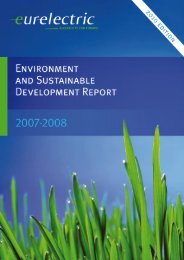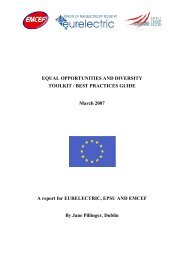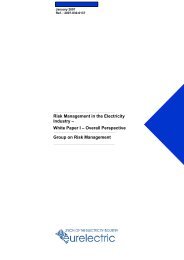Power Statistics - 2010 Edition - Full Report - Eurelectric
Power Statistics - 2010 Edition - Full Report - Eurelectric
Power Statistics - 2010 Edition - Full Report - Eurelectric
Create successful ePaper yourself
Turn your PDF publications into a flip-book with our unique Google optimized e-Paper software.
The climate dimension: towards carbon-free electricity<br />
Fossil fuel capacities remain, but a strong shift towards carbon<br />
reduction can be witnessed.<br />
Natural gas has been displacing oil and coal in the last<br />
decades, creating the so-called ‘dash-for-gas’. Thanks to the<br />
lower carbon content of the primary fuel, shorter construction<br />
lead-times and lower capital costs, a major deployment of<br />
combined cycle gas turbine plants (CCGTs) has been witnessed<br />
throughout the continent, with capacity of gas-dependent<br />
electricity increasing nearly fourfold from 37,266 MW in 1980<br />
to 138,745 MW in 2008. Natural gas is assumed to further<br />
increase in the upcoming decades, albeit at a slower pace.<br />
As back-up capacity, it will play a fundamental role in flexibly<br />
complementing the integration of intermittent renewables<br />
electricity into the EU electricity market.<br />
Oil-based electricity generation fell by more than 70 % between<br />
1980 and 2008. Nevertheless, oil-fired generating units are<br />
New installed capacities: RES dominates<br />
As shown in Figure 12, some 25 GW of new capacity have been<br />
added between 2007 and 2008, the majority of which (around<br />
60 %) was RES. Looking at the conventional fleet, numbers<br />
seem to suggest that the majority of new fossil-fuelled plants<br />
are fired with natural gas rather than coal and oil. The reversal<br />
of phasing out and nuclear lifetime extension in countries like<br />
Figure 12: Generating capacity in the EU-27 in 2009 compared<br />
to 2008 and 2007 (MW)<br />
still used for peaking purposes, i.e. in times of high electricity<br />
demand. Furthermore, some countries, especially small island<br />
systems such as Malta and Cyprus, still rely on oil to generate<br />
their electricity, although a shift towards gas is envisaged.<br />
Among solids, coal and lignite have experienced different<br />
evolution patterns. Despite maintaining or even increasing<br />
its absolute volumes, hard coal saw its shares plunge from<br />
44 % to 30 % of total fossil fuel fired production between<br />
1980 and 2008. By contrast, the use of lignite has been<br />
growing steadily both in absolute and in relative terms (from<br />
16 % in 1980 to 18 % in 2008), driven by its abundance in<br />
some EU countries.<br />
According to EURELECTRIC’s <strong>Power</strong> Choices Study carbon<br />
capture and storage (CCS) will influence the future use of<br />
coal and gas in the generation mix, provided the technology<br />
reaches maturity and commercial roll-out starts in the period<br />
2020-2025.<br />
Sweden and Germany add, mathematically, new capacities,<br />
although without setting up new plants. Preliminary statistics<br />
confirm that all generation sources increased their capacity<br />
in 2009 compared to 2008, with RES increasing from<br />
93,342 MW to 107,491 MW. Wind made up over two thirds of<br />
total installed RES capacity.<br />
2007 2008 2009 2008/2007 2009/2008<br />
Nuclear 132,855 132,882 132,876 27 -6<br />
Conventional Thermal 436,464 446,936 456,967 10,472 10,031<br />
Hydro 140,894 141,788 142,617 893 829<br />
Other RES 77,983 93,342 107,491 15,359 14,149<br />
of which Wind 55,394 63,611 74,335 8,217 10,724<br />
Total 791,233 815,515 841,732 24,282 26,217<br />
<strong>Power</strong> <strong>Statistics</strong> – <strong>2010</strong> <strong>Edition</strong> 19

















